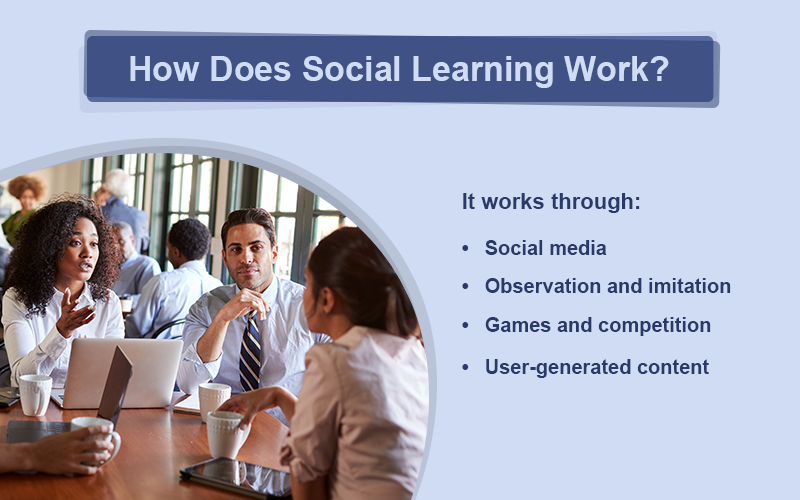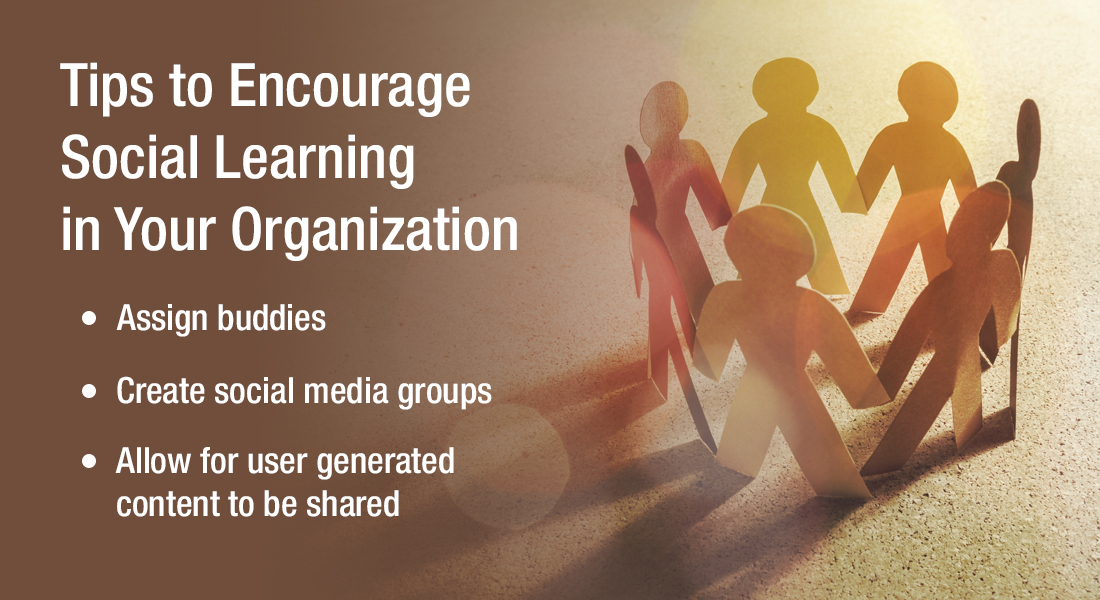Decoding Social Learning: How Collaboration Works in the Workplace
Social learning has long been part of informal workplace training. Explore how social learning can be integrated with corporate training.

Did you ever have a moment of, “This is the most fun I’ve had during training” during a self-learning session? Never, right? But I bet that thought has popped up during a brainstorming session or a group training activity or while listening to someone at some conference. Why do you think that happened? What made the difference? Well believe it or not, the learning experience was better because of the social setting. And this is the crux of the Social Learning Theory proposed by psychologist Albert Bandura in the late 70s.
| “Learning would be exceedingly laborious, not to mention hazardous, if people had to rely solely on the effects of their own actions to inform them what to do. Fortunately, most human behavior is learned observationally through modeling: from observing others one forms an idea of how new behaviors are performed, and on later occasions this coded information serves as a guide for action.” |
As much as Bandura’s research deserves credit; you don’t really need an academic theory to prove that we are social animals who always learn better and do better with others around to challenge and motivate us. Social learning has been practiced informally in corporate spaces for years, with even the 70:20:10 model saying that social interactions and relationships are responsible for 20% of all workplace learning.
Download this eLearning guide for the right brain.
But in this present world of social media and networking, social learning is no longer limited to a few tips from co-workers or a lunch-break meeting. So, let’s see how social learning works in today’s corporate workspaces.
Social Learning in Employee Training
How does it work?
- Learning through social media
- Learning through observation and imitation
- Learning through games and competition
- Learning through user-generated content
How Social Learning Works in the Corporate Workspace
Learning through Social Media

“Wait a minute…. Social media is addictive and distracts employees from work.” This is what training managers say when someone mentions social media in the context of training, and I get it, totally. Social media is addictive and for the longest time people tried to resist it and failed spectacularly. So, let’s see how this has been flipped into something amazing.
| In 2008 Cisco launched Cisco Learning Network, an online platform for training and certification exams as well as a community for networking professionals to interact and share ideas. The network played an important role in helping to train them to design, build, and manage more complex networks. The network allows learners to share videos, tutorials, and study guides. |
Many Learning Management Systems have adopted social media elements like discussion boards and messenger apps within the platform. Most businesses encourage and leverage their employees’ social presence in platforms like LinkedIn, Facebook, and Twitter that allows employees to connect, interact with their peers and industry experts, and build communities to share ideas and challenges.
Learning through Observation and Imitation

As Mark Twain once remarked, “There is no such thing as a new idea”, we are all copycats. We learn by observing and copying others. But that doesn’t make it necessarily bad.
| According to research by Indiana University on ‘Social Learning Strategies in Networked Groups’ it is better to be surrounded by copycats than innovators because, “Imitators often make their own improvements to the original solution, and these can, in turn, be adopted and improved upon by the originator and others.” |
In the corporate workplace, apprenticeship, job shadowing, peer-mentoring, etc., are all based on learning through observation and imitation. And these are all forms of social learning.
With online training, this idea becomes even more powerful and efficient. We follow people we work with, people we admire on various social platforms. We build on the ideas of others and use it to hone our skills and performance. A possible query when discussed in an online forum generates multiple solutions, because learners will add in their own experiences.
Learning through Games and Competition

A lone player is no player! From football team practice to playing with virtual players in Fortnite, games have always been a social activity. They pose challenges and encourage players – both of which are excellent motivators for a group to learn together.
Play and social learning have always gone hand in hand. Role-playing team challenges at the workplace and eLearning elements like badges and LMS leaderboards – all take their cue from the idea of learning through games. And with millennials crowding the workplace, there is no better way catch their attention.
According to a Forbes article, 67% of millennial workers agree that video games teach them winning strategies, 70% think it helps them become better problem-solvers, 63% that it enhances their abilities to work in a team. In such a scenario, there are no better training choices than gamification and game-based designs.
Performance Support through User-Generated Content

A long time ago… (okay, more like 15 years ago) people used to go to a library when they wanted to learn about something; today we have Google. This is the day and age of user-generated content. Type in anything, however silly, and you will see a dedicated Quora post with long threads of messages on it.
When implemented in the LMS through discussion boards and chatrooms, this will form an online repository of tips, comments, and opinions from learners as well as SMEs. Since all the comments and feedbacks are streamlined, users looking for solutions can readily access and go through the discussions. It works like an informal manual you can consult any time when the need arises.
Summing It Up!
So, there you have it. Socializing, community building, having fun while learning; all elements of corporate training in one simple strategy. Unlike other L&D trends which may fade away with time, social learning has always been a part of corporate learning and will remain so for a long time. Check the trends being adopted by best-in-class organizations this year!





